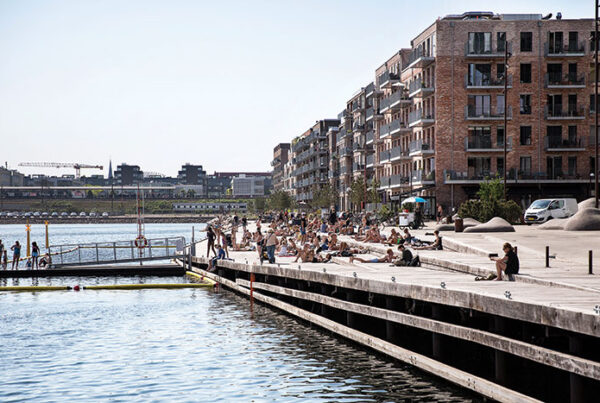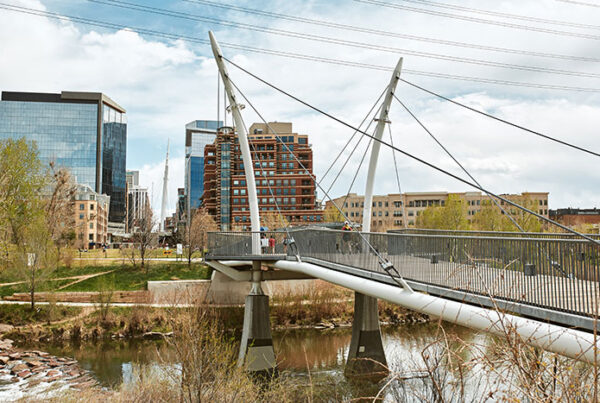Environmental Justice and Real Estate: Perspectives from Leading Community-Based and Advocacy Organizations is a collection of interviews that aims to show why environmental justice is an essential consideration in urban development, and how ULI members and the broader real estate industry can incorporate its principles into their everyday work. Equity and ESG topics are increasingly central to real estate, and companies that form lasting partnerships with communities can simultaneously further social, economic, and climate goals for all.
The essays and interviews comprise a range of influential figures, from real estate leaders to community activists, and each one focuses on how environmental justice is a necessary component to correcting past inequities and creating thriving communities. The collection includes four question and answer-based interviews with partner organizations and two essays by ULI members.
“Part of moving the needle toward equity is listening to the input of those most affected by discriminatory practices,” said Sonia Huntley, senior vice president of diversity, equity, and inclusion (DEI) at ULI. “By including a wider variety of perspectives in decision-making, real estate can help make sure its impact on communities is positive.”
Each essay touches on a particular topic of environmental justice:
- A ULI Member Perspective: James Lima, president, James Lima Planning and Development and a member of ULI’s Sustainable Development Product Council, writes about how the Institute and its members can drive change in the real estate industry through partnerships and how the industry itself can benefit from putting environmental justice considerations into practice;
- Economic and Climate Justice: Zelalem Adefris, vice president of policy and advocacy at Catalyst Miami, talks about climate gentrification, the disproportionate impact of pollution and climate risk on communities of color, and how Catalyst Miami is working with local stakeholders and policymakers to empower community leaders and address Miami’s twin climate and housing crises;
- Community Development and Grassroots Organizing: Michelle de la Uz, executive director of the Fifth Avenue Committee, discusses effective ways to organize change in local communities, partner with real estate actors, build environmental and climate considerations into the development process and increase pressure on policymakers and the industry to make environmental justice not just an idea, but an action;
- Equitable Renewable Energy: Shalanda H. Baker, professor of law, public policy, and urban affairs at Northeastern University, cofounder and former codirector for the Initiative for Energy Justice, and currently deputy director for energy justice with the U.S. Department of Energy, examine how energy burdens and high energy costs disproportionally affect lower-income households, especially Black, Latinx and Indigenous/Native American households, and how the real estate sector can embrace a “do-no-harm” approach by centering equity in the transition to renewables and facilitating small-scale energy projects in communities that bear the burden of pollution; and
- Empowerment and Climate Investment: Sonrisa Cooper, transformative communities program manager for the Greenlining Institute, considers the links between redlining and environmental injustice, the compounding effects of racial discrimination on community well-being, and how the real estate industry must acknowledge the harm it has caused and the pathways it can offer to drive equity moving forward.
A conclusion by Taidgh McClory, director of social impact & inclusion, MP Boston, founder, T.H. McClory LLC and member of ULI’s Responsible Property Investment Council lays out potential solutions for the real estate sector on environmental justice issues:
- Recognizing that all stakeholders are interconnected and interdependent, and everyone’s success relies on taking better care of each other;
- Leveraging existing innovative community ownership models to create equitable development;
- Understanding and acknowledging the legacy of past practices that have led to environmental injustice, disproportionally impacting communities of color;
- Embedding an equity-mindset that assesses impact and reduces the cluster of environmental burden (a “do-no-harm” policy); and
- Enshrining equitable development as a place-based approach for underserved communities.
“As we have learned from the community organization perspectives presented in this resource, the topic of environmental justice is complex,” said McClory. “The public and private real estate sectors have played a major role in determining which communities experience greater environmental, climate, and health risk, as evidenced by the past decisions, actions, and policies that led to the disparate impacts of redlining, industrial pollution, and infrastructure decline in communities of color. Acknowledging these negative impacts at the intersection of the real estate industry and environmental justice is a key first step for real estate leaders to build solutions that shape a future of positive impact.”
For more information, download the report on Knowledge Finder.




